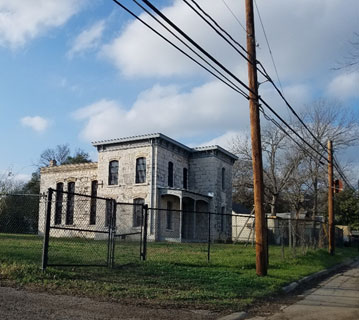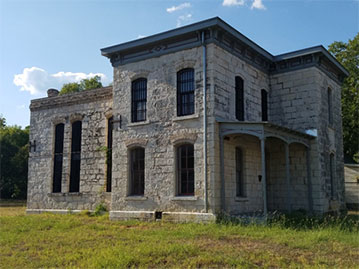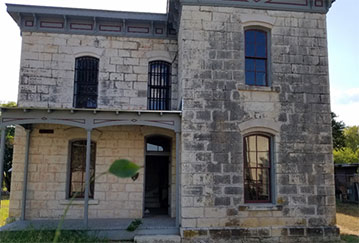Old Hays County Jail








The historic Hays County Jail (1884) is one of the most significant historic buildings in the County from the late nineteenth century. The distinctive Italianate design by Edward Northcraft (1833-1919) and B. F. Donaldson (dates unknown) is one of the few surviving examples of this style remaining in Texas. Northcraft, a renown Texas architect, also designed the Old Main Buildings at Texas State University and Sam Houston State University, the San Marcos Cemetery Chapel, and the First Christian Church (now part of the Price Center).
The Italianate style was first popularized in the United States by architect Alexander Jackson Davis(1803-1892). Characteristics of the style include: asymmetrical front facade with a deeply inset porch; tall and narrow windows with a rounded top; low-pitched roof supported by prominent brackets, and; decorative cornices on the top of the building and the porch. The two story jail building consists of two parts. The front L-shaped section contains two rooms on each story. The first floor was used for the Sheriff’s office and living area. The second floor contained his living quarters. It is not known if any Hays County Sheriffs actually lived in the jail, but newspaper articles mention a Sheriff Deputy and his family occupying the space. In later years, one of the upstater rooms was used as a separate jail area for women. The rear of the building contained a two story, open space where the actual jail cells were located. The steel jail cells have log since been removed and their location is not known.
The jail was witness to numerous events over the years. During the years of Reconstruction, it was common to construct jails near the African American community as a means of intimidation. Only one lynching from the jail of Tim Blocker has been documented, occurring in 1887. The only legal hanging, of Benjamin Guerrero, occurred in the yard of the jail in 1915. Anna Hauptreif, a notorious murderer of her children and husband, committed suicide in 1924 while awaiting her trial. The bank robbers, the Newton Brothers, were also jailed here in 1926. A movie about their string of bank and train robberies was filmed here in 1997. (The Newton Boys, released in 1998)
The county constructed a new jail in 1937 (located at the northeast corner of Guadalupe and MLK, but since demolished). After the county jail relocated, the 1884 jail was used by the City Mission Board for a “Mexican Social Center.” The Mission Board purchased property on S. Guadalupe in 1947 and began fundraising for the construction of a building for a “Latin-American Social Center.” The date of their move is not known, but it may have been in the late 1940s.
The Hays County Commissioners Court sold the building at public auction in 1952 to Oscar Payne. It remained in private ownership for over 50 years, being used for storage and as a construction yard. In 1998, a generous gift from Emmett McCoy allowed for the purchase of the building by Preservation Associates Inc., a non-profit devoted to historic preservation in Hays County (Hill Rylander was president of Preservation Associates at the time of purchase). The ownership was transferred back to Hays County in 2008 with a preservation easement to insure future County Commissioners Courts would continue to preserve the building or, in the event of its sale again, future owners would never demolish the building.
The restoration of the 1884 Hays County Jail building is under the supervision of the Hays County Historical Commission. This Commission has diligently pursued private grant funding from the Burdine Johnson Foundation for the restoration of this significant building. In 2009 Emily Little of Clayton Levy Little, Architects prepared a master plan to guide a phased restoration of the building. Over the years, the foundation has been repaired; a new roof replaced; masonry restored, and; all of the exterior wood and windows replaced. Currently, restoration of the interior is underway.
Along with the Hays County Courthouse, this is one of the county’s most important historic public buildings. The Hays County Jail was listed in the National Register of Historic Places in 1983 and designated a State Antiquities Landmark in 2008. In 2003, it became a part of the locally designated Dunbar Historic District.
The completed restoration of the Hays County Jail will be a cornerstone to the revitalization of the historic Dunbar African American community (a locally designated historic district). This project will complement the existing Calaboose African-American Museum, the Ulysses Cephas House and Eddie Durham Park, and the future restoration of the Dunbar Home Economic School and the historic Baptist Church (formerly known as the Dora Lee Brady Community Center).